A History of Saturday Morning
1968 – 1974: Prehistory
In which Pete Smith still rules, Shaw Taylor plays a few rubbers, and a homemade pinball machine invents Jamie Theakston’s future career.
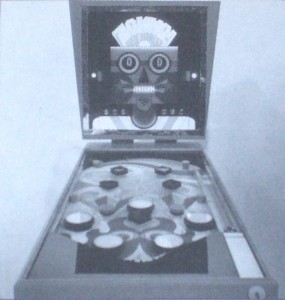 Saturday mornings were largely unexploited back in the ’60s, TV-wise. Both BBC1 and ITV contented themselves with a few cartoons, maybe a ‘matinee’ showing of an old family film, and similar ex-cinema shorts such as Tarzan, Laurel and Hardy, and Pete Smith Specialties. They knew the kids were eager to watch at this early hour, and Warner and Hanna-Barbera cartoons played the same role here as in the US, although not to the wall-to-wall extent American kids had traditionally enjoyed since the ’50s. Repeats of The Partridge Family and various items of Gerry Andersoniana started to appear later on. But these nuggets were mixed in willy-nilly with a fair amount of non-child-friendly filler – when your average ten-year-old chanced upon the likes of Ron Pickering’s Athlete, Improve Your Bridge with Shaw Taylor or Developments in Social Work, a change of channel (or, more likely, activity) swiftly followed. On occasion, the BBC tried a bit of ‘umbrella’ programming to bind the kid’s stuff together – 1968’s [cref 1054 Zokko] (a talking pinball table built by Janet Ellis’ dad) and the Paul ‘Rentaghost/Caron Keating-era TOTP’ Ciani-produced Outa-Space! in the early ’70s (a spaceship control panel) were used as novel linking devices in between cartoons, picture stories (made in-house) and educational shorts. Hardly groundbreaking television, but a new idea was there – keep the kids watching with a bit of continuity. These early experiments aside, it would be a few years before the continuity began taking over from the cartoons, and Saturday Mornings As We Know Them took shape.
Saturday mornings were largely unexploited back in the ’60s, TV-wise. Both BBC1 and ITV contented themselves with a few cartoons, maybe a ‘matinee’ showing of an old family film, and similar ex-cinema shorts such as Tarzan, Laurel and Hardy, and Pete Smith Specialties. They knew the kids were eager to watch at this early hour, and Warner and Hanna-Barbera cartoons played the same role here as in the US, although not to the wall-to-wall extent American kids had traditionally enjoyed since the ’50s. Repeats of The Partridge Family and various items of Gerry Andersoniana started to appear later on. But these nuggets were mixed in willy-nilly with a fair amount of non-child-friendly filler – when your average ten-year-old chanced upon the likes of Ron Pickering’s Athlete, Improve Your Bridge with Shaw Taylor or Developments in Social Work, a change of channel (or, more likely, activity) swiftly followed. On occasion, the BBC tried a bit of ‘umbrella’ programming to bind the kid’s stuff together – 1968’s [cref 1054 Zokko] (a talking pinball table built by Janet Ellis’ dad) and the Paul ‘Rentaghost/Caron Keating-era TOTP’ Ciani-produced Outa-Space! in the early ’70s (a spaceship control panel) were used as novel linking devices in between cartoons, picture stories (made in-house) and educational shorts. Hardly groundbreaking television, but a new idea was there – keep the kids watching with a bit of continuity. These early experiments aside, it would be a few years before the continuity began taking over from the cartoons, and Saturday Mornings As We Know Them took shape.
1974 – 1982: Wake Up and Swap
In which Noel gets an idea, Keith gets a wife, and Birmingham takes over the country
For a long time, things carried on as usual. Arthur Of The Britons, Farmhouse Kitchen, Bugs Bunny, Asian Magazine. Then on ATV in 1974, a programme called Today Is Saturday began.
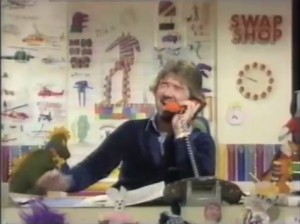 But for most of the country, by 1976 it was still a selection of odds and sods when it came to Saturday morning on both channels. It took non-record-owning Radio 1 DJ Noel Edmonds to give BBC mornings a format that would stick around, with only a few cosmetic alterations, for at least 25 years. Noel had experimented with kids’ TV the previous year, in a series of short afternoon phone-in shows called Z-Shed, where he would converse with the kids on a set topic much as he did on the radio. The [cref 3091 Multi-coloured Swap Shop] aimed to add to this phone-interactivity with pop guests, news, chat and, crucially, the swaps – originally conceived as a platform for kids to talk about their hobbies (one child was invited onto each show to show off their wares – a boy with an extensive lightbulb collection, who’d been on Blue Peter previously, was the first such guest), and celebrities who happened to collect stuff pitched in too. Swaps were also the main crux of the phone-ins – a toycentric bartering system sprang up during the course of each edition, its progress commented on by Noel – and of course Keith Chegwin was despatched to a damp recreation ground to hold second-hand board games just out of the reach of a hundred tiny hands while his loose change was surreptitously liberated by some of the less fair-minded of the crowd. The swap ‘n’ chat device may seem a bit quaint now, but it certainly played a part in fostering a kind of community spirit around the show.
But for most of the country, by 1976 it was still a selection of odds and sods when it came to Saturday morning on both channels. It took non-record-owning Radio 1 DJ Noel Edmonds to give BBC mornings a format that would stick around, with only a few cosmetic alterations, for at least 25 years. Noel had experimented with kids’ TV the previous year, in a series of short afternoon phone-in shows called Z-Shed, where he would converse with the kids on a set topic much as he did on the radio. The [cref 3091 Multi-coloured Swap Shop] aimed to add to this phone-interactivity with pop guests, news, chat and, crucially, the swaps – originally conceived as a platform for kids to talk about their hobbies (one child was invited onto each show to show off their wares – a boy with an extensive lightbulb collection, who’d been on Blue Peter previously, was the first such guest), and celebrities who happened to collect stuff pitched in too. Swaps were also the main crux of the phone-ins – a toycentric bartering system sprang up during the course of each edition, its progress commented on by Noel – and of course Keith Chegwin was despatched to a damp recreation ground to hold second-hand board games just out of the reach of a hundred tiny hands while his loose change was surreptitously liberated by some of the less fair-minded of the crowd. The swap ‘n’ chat device may seem a bit quaint now, but it certainly played a part in fostering a kind of community spirit around the show.
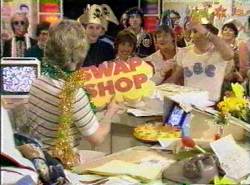 At the centre of operations, Noel, behind his DJ-style desk, held affable court. This was, remember, a long time before he started running about over-frantically in the name of adult entertainment. Seated, stripey t-shirt on chest and mug of BBC tea in hand, Edmonds was the quintessential ‘eccentric uncle’ type that kids’ TV thrived on back then (to be superceded some time in the ’80s by the ‘big bruv’ presenter, natch). Sometimes he moved to the right of the desk and stood up, or even further to the right and sat on a sofa. Cheggers’ braying laugh on the monitor as he drowned in a sea of Buckaroo bidders in a Leeds rec was as ‘manic’ as the show ever threatened to get, and if that put some kids off, for others it was an ideal pre-lunch pace. For six seasons, very little changed – the swaps became less prominent (but, unlike many other Saturday shows, the original format was never abandoned) giving way to magazine-style items and interviews, Cheggers was paired up with Maggie Philbin (which led to a real life romance, although this was only occasionally referred to – it not being ‘the done thing’ to have too much of the presenters’ private lives divulged on air at the time – presenters as celebs in their own right wouldn’t emerge until the end of the ’80s) a special awards ceremony was held, and for the last series a new theme and logo were unveiled. By then Edmonds’ ambitions had tempted him into other areas of TV, and Swap Shop ended in ’82, but not before it laid down a valuable ground rule for the Saturday morning format – include the audience, don’t patronise them. Alas, not enough future morning productions took this lesson to heart, and by the time The Late, Late Breakfast Show was in its pomp, Edmonds seemed to have totally forgotten it, too. Ah well, he was good once.
At the centre of operations, Noel, behind his DJ-style desk, held affable court. This was, remember, a long time before he started running about over-frantically in the name of adult entertainment. Seated, stripey t-shirt on chest and mug of BBC tea in hand, Edmonds was the quintessential ‘eccentric uncle’ type that kids’ TV thrived on back then (to be superceded some time in the ’80s by the ‘big bruv’ presenter, natch). Sometimes he moved to the right of the desk and stood up, or even further to the right and sat on a sofa. Cheggers’ braying laugh on the monitor as he drowned in a sea of Buckaroo bidders in a Leeds rec was as ‘manic’ as the show ever threatened to get, and if that put some kids off, for others it was an ideal pre-lunch pace. For six seasons, very little changed – the swaps became less prominent (but, unlike many other Saturday shows, the original format was never abandoned) giving way to magazine-style items and interviews, Cheggers was paired up with Maggie Philbin (which led to a real life romance, although this was only occasionally referred to – it not being ‘the done thing’ to have too much of the presenters’ private lives divulged on air at the time – presenters as celebs in their own right wouldn’t emerge until the end of the ’80s) a special awards ceremony was held, and for the last series a new theme and logo were unveiled. By then Edmonds’ ambitions had tempted him into other areas of TV, and Swap Shop ended in ’82, but not before it laid down a valuable ground rule for the Saturday morning format – include the audience, don’t patronise them. Alas, not enough future morning productions took this lesson to heart, and by the time The Late, Late Breakfast Show was in its pomp, Edmonds seemed to have totally forgotten it, too. Ah well, he was good once.
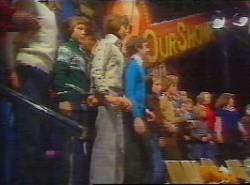 With Tiswas stealthily conquering the ITV regions like a Brummie version of the Dad’s Army arrows, by the end of the decade there was a battle going on for the eyes of the nation’s children. Tiswas, keen to be seen as the low-budget underdog, played up to this no end, with Tarrant and co sarcastically refering to the Other Side’s flagship on occasion. Noel, for his part, stayed silent on screen, but dissed The ‘Was off camera as a worthless gunkfest (though that wouldn’t stop him launching his own ‘take’ on crap-hurling a decade later on). Those ITV regions who were yet to clock Tarrant and co., meanwhile, subsisted on varied fare. From 1976-78, Our Show ‘did’ for London and the south – a hotchpotch magazine presented “by the kids (read – cocky, badge-festooned blighters trying a tad too hard to look a bit ‘street’ in a junior Nozn’ Aroun’ style) for the kids (read – not many kids)”, which didn’t even have the curiosity value of live cock-ups, filmed as it was a few days before transmission. Its contributions to TV clip shows (the familiar ‘Grand Pricks’ outburst and a young Susan Tully) give it a greater foothold in the public memory than it probably deserved.[cref 6452 The Saturday Banana] was Southern’s contribution in 1978, and in temporarily-resting Goodie Bill Oddie found a better host than most. The ramshackle production echoed Tiswas, though without the brute force of Tarrant it sometimes fell apart less than magnificently. Two other ITV kids’ series, Mike Reid’s Runaround (in a regular game show segment) and a nascent Metal Mickey, intruded into the mix, at the behest of Southern’s Lewis Rudd (who would later move to Central/ATV and become one of the main factors in finishing off Tiswas itself). Even Tiswas-hating Rudd was forced to switch to importing ATVLand’s output after a season of this effort.
With Tiswas stealthily conquering the ITV regions like a Brummie version of the Dad’s Army arrows, by the end of the decade there was a battle going on for the eyes of the nation’s children. Tiswas, keen to be seen as the low-budget underdog, played up to this no end, with Tarrant and co sarcastically refering to the Other Side’s flagship on occasion. Noel, for his part, stayed silent on screen, but dissed The ‘Was off camera as a worthless gunkfest (though that wouldn’t stop him launching his own ‘take’ on crap-hurling a decade later on). Those ITV regions who were yet to clock Tarrant and co., meanwhile, subsisted on varied fare. From 1976-78, Our Show ‘did’ for London and the south – a hotchpotch magazine presented “by the kids (read – cocky, badge-festooned blighters trying a tad too hard to look a bit ‘street’ in a junior Nozn’ Aroun’ style) for the kids (read – not many kids)”, which didn’t even have the curiosity value of live cock-ups, filmed as it was a few days before transmission. Its contributions to TV clip shows (the familiar ‘Grand Pricks’ outburst and a young Susan Tully) give it a greater foothold in the public memory than it probably deserved.[cref 6452 The Saturday Banana] was Southern’s contribution in 1978, and in temporarily-resting Goodie Bill Oddie found a better host than most. The ramshackle production echoed Tiswas, though without the brute force of Tarrant it sometimes fell apart less than magnificently. Two other ITV kids’ series, Mike Reid’s Runaround (in a regular game show segment) and a nascent Metal Mickey, intruded into the mix, at the behest of Southern’s Lewis Rudd (who would later move to Central/ATV and become one of the main factors in finishing off Tiswas itself). Even Tiswas-hating Rudd was forced to switch to importing ATVLand’s output after a season of this effort.
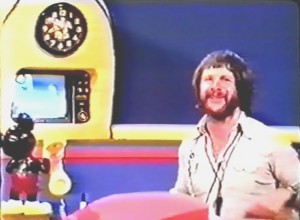 |
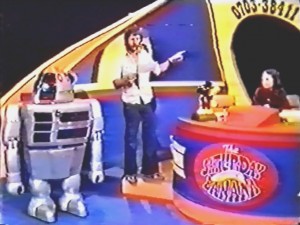 |
Summer alternatives were slim pickings at this time – the Beeb offered much the same CFF films and cartoons as of old, while ITV gave us two regional efforts courtesy Granada. [cref 2995 The Mersey Pirate] (June-Aug 1979) was a rum affair indeed – ‘Captain’ Duggie Brown oversaw antics broadcast live from The Royal Iris, a ferry cruising up and down the Liverpool docks. On-board entertainments were managed by Billy Butler, presenting various We Are The Champions activities for kids on Top Deck (for ‘pirate mug’ prizes), there was a ship’s disco which played host to various pop acts, a certain Fred Talbot doling out astronomical facts, and various loosely-nautical support acts including ship’s cook Bernard Wrigley, ‘Chief Petty Officer’ Peter Grayson and Scully and Mooey, two comedy stowaways for Butler to chase after whenever the pace slackened. Features included ‘Decked Out’ (fashion with Therese Birch), ‘Ship Shape’ (on board keep fit with Dave Prowse), The Independent Pirate News at Ten to Eleven (excuse for Frank Carson and other comedians to do sub-Two Ronnies gags at a desk) and of course, the National UK Top 20 “direct from the Record Business computer, London.”
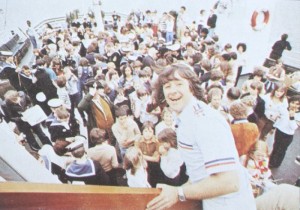 |
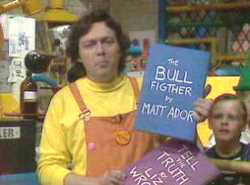 |
Despite all this, the show is chiefly remembered for the frequent failiure of its over-ambitious technical set-up. The live transmission from the ship involved a land-based Granada tech, stuck up a suitably tall structure in the docks, physically pointing a hand-held UHF receiver in the direction of the Iris to get a decent signal. Needless to say, this didn’t run smoothly all the time, giving accidental credibility to the show’s claim to be run from a ‘pirate’ TV station. Further problems were caused by the weather and various spates of industrial action. Usual result – cartoons and George Reeves’ old Superman serial instead. The following summer, Granada tried again with [cref 2353 Fun Factory], two hours of ‘mayhem’ and talent contests (‘Krazy Kids’) with a wisely land-based fictional location. “As workers clock in, tea breaks become fun breaks!” chirped Granada’s publicity. Billy Butler, Therese Birch, Martin Day and DJ Ray Teret were carried forward from the ‘Pirate, joining a young, dungareed Jeremy ‘Beadlebum’ Beadle, Wilf Lunn-built robot Kurt Knobbler and, for a few weeks only, future Poparound presenter and Rage! magazine insitgator Gary Crowley, who rather dubiously played a retarded manchild, and probably sealed his fate on the show by pretending to sodomize Butler with an inflatable banana. Beadle also departed for the more prosperous environs of Game For A Laugh, and the Fun Factory followed the paths of many of its real life counterparts in the ’80s and shut its gates for good at the end of August.
1982 – 1985: Less Of The Same
In which Big Daddy stays at home, Mike treads water, and Sandi makes it up as she goes along.
In October of ’82, after the first episode of Star Fleet, a new Central show filled the old ‘Was slot nationwide – billed as Big Daddy’s Saturday Show, it promised a familiar mix of competitions and Warner cartoons, music (Pop Newsbeat taking over from Sally James’ Almost Legendary interviews) and Fair Play, kid-friendly campaigns in the same vein as the old ‘Was ‘crusades’. It was all linked by ex-Generation Game foil Isla St. Clair and former radio jock Tommy Boyd, and based around the ‘larger than life’ personality of the titular wrestler, who was set up in the publicity as a kind of rival to Jimmy Saville – “Big Daddy will make children’s dreams come true … he’s the children’s champion.” Unfortunately, mere days before the first show went out, the former Shirley pulled out of the project after the first of several health scares, and Boyd and St Clair were left on their own fronting the quickly-renamed [cref 6465 Saturday Show] – all the old features from Tiswas (plus the new Talented Teachers contest), only minus the impromptu, irreverent style. And the flans.
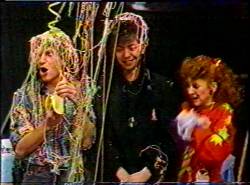 |
 |
Boyd manfully tried to inject some personality into it (he had a weekly at-desk freeform rant about an aspect of children’s pop culture which was the most entertaining studio-based item in the show) and there was heavy cross-promotion of the like Tiswas never received (Isla appeared as ‘herself’ on Metal Mickey on the day the first show went out, she and Boyd later scored a double-header appearance on Punchlines), but, apart from a roster of reliably early ’80s ‘big name’ guests (the first show boasted Shakin’ Stevens, Rod Hull, Chas and Dave and Steve Davis) the show didn’t capture the public imagination, and secured one more series (with Jimmy Greaves drafted in to fill a very Trevor East-like Sportsdesk role) before being retreaded in autumn of ’84 as[cref 6473 Saturday Starship], with a loosely-themed “we’re in space” gimmick, St. Clair replaced by Bonnie Langford (performing her very own Saturday Starship dance, of course) and the running time shorn to 80 minutes. This feeble reincarnation took an early bath at the end of January 1985.
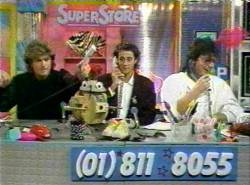 The Beeb’s replacement for Swap Shop fared better, but was similarly a pale rehash of the previous show – almost shamelessly so, it seemed. Even the initials were the same! [cref 6490 Saturday Superstore added a capitalist spin to the Swap Shop conceit, with different strands referred to as ‘departments’, competitions as ‘bargains’, Keith Chegwin carried forward in out-and-about capacity as ‘delivery boy’, John Craven also kept on, David Icke drafted in, another BA Robertson theme commissioned (and performed by unlikely ’80s supergroup The Assistants – Cheryl Baker, Dave Edmunds, Suzi Quatro and Junior), and a even batch of ‘Store carrier bags printed up. First show guests included Paul Daniels and Howard Jones, whose mime-dancer Jed had a confusing ‘conversation’ with Cheggers in the separate ‘bargain basement’ set. It was bigger than the ‘Shop – a larger set, more guests, more money, more ‘girls’ ‘manning’ the phones behind the Big Desk. A studio audience of kids was introduced – referred to as ‘customers’, of course. But at least half the success of Swap Shop was down to Noel Edmonds’ slightly mischievous, irreverent touch. Superstore had Mike Read. Another Radio One breakfast jock, Read was laid back and likeable enough on the wireless, as Noel was. But he wasn’t so at home on TV, and that Great Big Store left him looking lost more often than not. In lieu of the spontaneous banter of old, staged ‘gags’ with the rest of the cast (jokes about Ready forgetting to set his alarm properly, and forever dragging his guitar out in an always-thwarted attempt to sing) and puppet sidekicks (the Posh Pawsian robot Sievehead, and rather more vocal – and annoying – Scouse ‘Crow’) were cooked up. Superstar chums of Read’s dropped in (Cliff Richard), phoned up (Simon le Bon), or were name-dropped by Ready in an ‘I was playing tennis on Thurday with…’ way (Cliff again). As the show progressed, Sarah Greene joined as the show’s ‘Saturday girl’, and the original format (as is so often the case) was largely forgotten, and Superstore became a fairly standard Saturday morning show, beating its beleagered ITV rivals mainly through a larger budget and better guests, but Read never really ‘settled in’ and nothing gelled quite as it used to – the cosy familiarity of old, which, to be fair, Read probably could have had a crack at generating on a smaller scale show, was gone.
The Beeb’s replacement for Swap Shop fared better, but was similarly a pale rehash of the previous show – almost shamelessly so, it seemed. Even the initials were the same! [cref 6490 Saturday Superstore added a capitalist spin to the Swap Shop conceit, with different strands referred to as ‘departments’, competitions as ‘bargains’, Keith Chegwin carried forward in out-and-about capacity as ‘delivery boy’, John Craven also kept on, David Icke drafted in, another BA Robertson theme commissioned (and performed by unlikely ’80s supergroup The Assistants – Cheryl Baker, Dave Edmunds, Suzi Quatro and Junior), and a even batch of ‘Store carrier bags printed up. First show guests included Paul Daniels and Howard Jones, whose mime-dancer Jed had a confusing ‘conversation’ with Cheggers in the separate ‘bargain basement’ set. It was bigger than the ‘Shop – a larger set, more guests, more money, more ‘girls’ ‘manning’ the phones behind the Big Desk. A studio audience of kids was introduced – referred to as ‘customers’, of course. But at least half the success of Swap Shop was down to Noel Edmonds’ slightly mischievous, irreverent touch. Superstore had Mike Read. Another Radio One breakfast jock, Read was laid back and likeable enough on the wireless, as Noel was. But he wasn’t so at home on TV, and that Great Big Store left him looking lost more often than not. In lieu of the spontaneous banter of old, staged ‘gags’ with the rest of the cast (jokes about Ready forgetting to set his alarm properly, and forever dragging his guitar out in an always-thwarted attempt to sing) and puppet sidekicks (the Posh Pawsian robot Sievehead, and rather more vocal – and annoying – Scouse ‘Crow’) were cooked up. Superstar chums of Read’s dropped in (Cliff Richard), phoned up (Simon le Bon), or were name-dropped by Ready in an ‘I was playing tennis on Thurday with…’ way (Cliff again). As the show progressed, Sarah Greene joined as the show’s ‘Saturday girl’, and the original format (as is so often the case) was largely forgotten, and Superstore became a fairly standard Saturday morning show, beating its beleagered ITV rivals mainly through a larger budget and better guests, but Read never really ‘settled in’ and nothing gelled quite as it used to – the cosy familiarity of old, which, to be fair, Read probably could have had a crack at generating on a smaller scale show, was gone.
It was down to the summer alternatives to provide a bit of spice to this pretty bland state of affairs. The BBC fared even worse here, though – their first stabs at a coherent summer strand, various Mark Curry-fronted miscellanies from Manchester’s Oxford Road ([cref 3253 Get Set For Summer], [cref 3253 The Get Set Picture Show], [cref 3253 The Saturday Morning Picture Show]) marked time during the months that were traditionally considered not worth trying too hard in. Genuine inspiration came from the ITV regions, however, in the form of TVS’ summer slot [cref 1519 Number 73]. Broadcasting to most regions from May 7th ’83, the show had a conceit more overpoweringly convoluted even than Superstore‘s – main presenter Ethel Davis (Sandi Toksvig) was landlady of a Maidstone terraced house, and her co-presenters – initially rollerskating Dawn Lodge, hapless Harry Stern, and Alec Simmons – were tennants. Moreover, in between introducing cartoons (the icky plasticine Rushtonfest Trapdoor was a major draw), music and semi-educational features (often involving zoo vet David Taylor), the cast would be prone to breaking off to deal with an ongoing plot centering around their notional ‘everyday lives’ in a semi-improvised style.
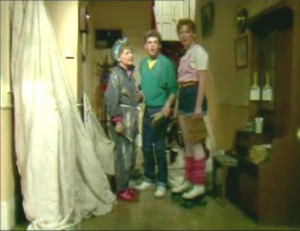 |
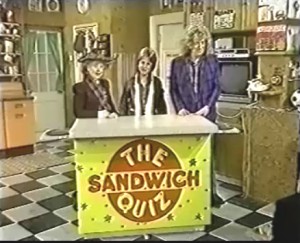 |
What could have been an embarrassing case of over-egging was handled well though, and kids warmed to the small-scale, domestic-yet-frequently-surreal world of ’73 quickly, so much so that it was moved from summer to the ‘main’ season in ’85, taking the place of the cancelled Starship, and providing a welcome antidote to the straight and stiff ‘Store. Unusually for these shows, ’73 managed to stay reasonably true to its narrative conceit throughout its four years, despite several cast upheavals along the way (Neil Buchanan, Kim Goody and Tony Aitken were notable additions, for better or worse). The format was, indeed, fairly central to the show (Sandi and the gang weren’t even credited by their real names until 1986) and in its own way became as unique and, to the casual viewer, impenetrably strange as Tiswas – where else could you find Boy George being challenged to ‘go for a currant layer’ in the ever-popular Sandwich Quiz, before everyone piled down to the basement to watch a soft toy-violating Iggy Pop, or Alien Sex Fiend? For a couple of years in the mid ’80s, the old order was restored – sober, professional BBC vs. hectic, homemade regional ITV. But this wasn’t to last long. After years of getting what a few production staff thought would be ‘a good idea’, ’80s kids were about to be ‘targeted’…
1985 – 1991: Hey Kids!
In which Janet and David think they know what the kids want, a lump of rubber actually does know what the kids want, and Phil takes too many jobs at once.
It’s forever reiterated in Saturday morningworld that the goal is to get both the young kids and the teenagers watching. The ‘Was, of course, managed this almost without trying; SM:TV benefits from the ‘get ’em young’ philosophy of present day popular culture. But by the mid ’80s producers found themselves caught between two very distinct markets: silliness and cartoons for the under twelves, or pop, comedy and ‘issues’, the things that (so it was assumed) teenagers wanted? In the autumn of ’85, Granada and Central (under the aegis of producer and future ITV controller David Liddiment) launched [cref 3609 TX: Ready For Transmission], a show which went for broke with ‘cool’ ’80s graphics in the title sequence, an odd mix of presenters in Sue ‘First Post‘ Robbie, Alison ‘Liz Archer’ Dowling and Tony ‘Alfresco‘ Slattery, and the accent firmly on pop interviews (Slattery ‘hung’ with the Thompson Twins in Liverpool in the opening show) and ‘issue’-based featurettes (eg. The State Of Our School Dinners). Ron Freethy contributed thoughtful Nature Notes, and Frank Sidebottom stuck his proto-ironic oar in for a series of special non-reports (the papier-Freshie was also ‘doing’ No. 73 at about this time). Also thrown into the mix were cartoon break bumper comedian Watt The Devil and the ever-popular Professor Stanley Unwin. Luckily for the smaller kids, there was the chaotic game show Knock Your Block Off and the ever-present cartoons to fall back on. This modified mix didn’t get the kids out of bed at the earlier 9.25 start though, and Liddy’s revolution was all over by Christmas. Ethel and the gang came capering back the following month.
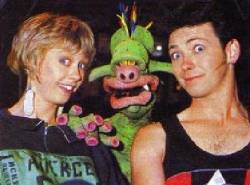 More teen appeal was scheduled for the following summer however, this time exec produced by another future TV mogul (of sorts), Janet Street-Porter. [cref 3243 Get Fresh!] came from a variety of ITV regions, entirely on location in a park or castle grounds, a la the old Swaperamas. The premise was that clapped-out comedy spaceship the Millennium Dustbin, containing Gareth ‘Gaz Top’ Jones, Charlotte Hindle, Nino ‘SPLASH‘ Firetto and, initially, Nescafe Chart man David Jensen, crash-landed at a different public place each week, thus heralding a mix of recorded pop interviews, gunge-related video game contests, mediocre cartoon Centurions, old-school comedy from Gary Wilmot and alternative comedy via ‘anarchic’ double act The Vicious Boys and (significantly) Phil Cornwell’s Gilbert the Alien, all within a sort of crusty sci-fi travelling funfair ambience. Appropriately very proto-‘yoof’, it did fairly well for two summers, thanks mainly to the word-of-mouth value of Cornwell’s extra-curricular sewer-of-conciousness babbling. The ’87 series saw a short Sunday ‘extra’ studio-bound edition (Number 73 copied the trick in its last series) and a repeat of disasterous TOTP-baiter The Roxy appended to fill out the 2 1/2 hours, by which time Street-Porter had moved on to Network 7 and ‘the start of a new generation of television’.
More teen appeal was scheduled for the following summer however, this time exec produced by another future TV mogul (of sorts), Janet Street-Porter. [cref 3243 Get Fresh!] came from a variety of ITV regions, entirely on location in a park or castle grounds, a la the old Swaperamas. The premise was that clapped-out comedy spaceship the Millennium Dustbin, containing Gareth ‘Gaz Top’ Jones, Charlotte Hindle, Nino ‘SPLASH‘ Firetto and, initially, Nescafe Chart man David Jensen, crash-landed at a different public place each week, thus heralding a mix of recorded pop interviews, gunge-related video game contests, mediocre cartoon Centurions, old-school comedy from Gary Wilmot and alternative comedy via ‘anarchic’ double act The Vicious Boys and (significantly) Phil Cornwell’s Gilbert the Alien, all within a sort of crusty sci-fi travelling funfair ambience. Appropriately very proto-‘yoof’, it did fairly well for two summers, thanks mainly to the word-of-mouth value of Cornwell’s extra-curricular sewer-of-conciousness babbling. The ’87 series saw a short Sunday ‘extra’ studio-bound edition (Number 73 copied the trick in its last series) and a repeat of disasterous TOTP-baiter The Roxy appended to fill out the 2 1/2 hours, by which time Street-Porter had moved on to Network 7 and ‘the start of a new generation of television’.
About this time, changes were afoot at the Beeb. Superstore, though not really threatened by any of the ITV rivals in ratings terms, was being pensioned off after five years’ steady yet undistinguished service. Perhaps the ITV upstarts were being acknowledged at last, but someone had decided a ‘fresher’, faster approach was needed. In typically BBC fashion, the result was Going Live. The format was largely the same as Superstore‘s (phone-ins, comps, talent contests, studio audience) but the ‘shop’ gimmick was wisely dropped in favour of a straight ‘here’s the show’ presentation. Sarah Greene was kept on, now promoted to main presenter alongside Philip Schofield, a broom cupboard signing rather than a DJ, and a younger, more brotherly type than Read.
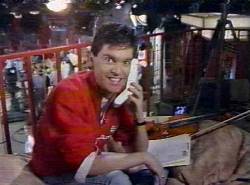 |
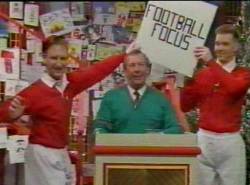 |
Items were sped up, more OBs introduced, Cheggers Plays Pop was Trocadero-ised with Peter Simon’s Double Dare (later Run The Risk with added Shane Richie) and comedy made its way into the show via Trev Neal and Simon Hickson, a deranged duo who did their own camply surreal character sketches, terrorised celebs, dropped blatant innuendoes, talked back to the presenters and double-handedly provided that ‘Wasian element of anarchy that the BBC shows had resisted for so long. Now the serious and sedate (Hot Seat interviews, Jonathan Porrit’s eco-news, agony uncles, book reviews and Emma ‘Bryan’ Forbes’ abortive attempts to get The Scofe to cook) sat alongside the bizarre (The Singing Corner, World of the Strange, Sofa For Two For Three), and at last the BBC were beating ITV at their own game.
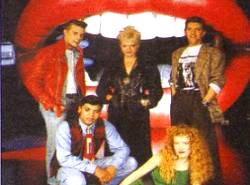 Especially when ITV’s game, from ’88, was Motormouth. After TVS wound up No. 73 (with a final half-arsed and inexplicable relocation to a Wild West theme park for 7T3), old stagers Andrea ‘Dawn’ Arnold and Neil Buchanan were joined by Tony Gregory and, later, Gaby Roslin and Andy Crane, defecting from the same broom cupoard background as Scofe, for a straight studio-bound miscellany of mag items, pop and cartoons, and Mousetrap!, an outsize version of the old kids’ board game hosted in a separate section of the show by Steve Johnson, in much the same manner as TX‘s KYBO. The sole innovation was Spin Off, a slice of 73esque po-mo comedy-soap set in the notional production offices of the main show and performed by a cast including Roger Sloman and a returning Sandi Toksvig. By its fourth series in ’92 though, this unremarkable show was occasionally outperforming The ‘Live (albeit a ‘Live hobbled by a temporary lack of Trev and Simon, and struggling with replacements Hickish and Ball, not to mention the first-hour enforced absence of Pip due to Technicolour Dreamcoat commitments – he was replaced by Kristian ‘Todd’ Schmidt, Jason Donovan, Shane Ritchie, etc.) but died with TVS at the end of that spring.
Especially when ITV’s game, from ’88, was Motormouth. After TVS wound up No. 73 (with a final half-arsed and inexplicable relocation to a Wild West theme park for 7T3), old stagers Andrea ‘Dawn’ Arnold and Neil Buchanan were joined by Tony Gregory and, later, Gaby Roslin and Andy Crane, defecting from the same broom cupoard background as Scofe, for a straight studio-bound miscellany of mag items, pop and cartoons, and Mousetrap!, an outsize version of the old kids’ board game hosted in a separate section of the show by Steve Johnson, in much the same manner as TX‘s KYBO. The sole innovation was Spin Off, a slice of 73esque po-mo comedy-soap set in the notional production offices of the main show and performed by a cast including Roger Sloman and a returning Sandi Toksvig. By its fourth series in ’92 though, this unremarkable show was occasionally outperforming The ‘Live (albeit a ‘Live hobbled by a temporary lack of Trev and Simon, and struggling with replacements Hickish and Ball, not to mention the first-hour enforced absence of Pip due to Technicolour Dreamcoat commitments – he was replaced by Kristian ‘Todd’ Schmidt, Jason Donovan, Shane Ritchie, etc.) but died with TVS at the end of that spring.
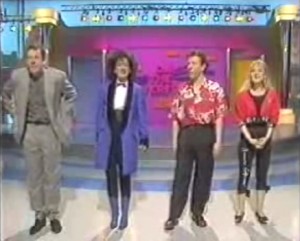 Summers in the late ’80s were filled with patchy recombinations of old ideas. The Beeb began to dip their toe into full-on No. 73 narrative in 1987 with the shambolic [cref 1336 It’s Wicked!] which combined on-location exclamation marked yoofisms a la Get Fresh!, poorly-realised links via a fictional couple watching the show on a sofa, and Jake Abrahams. The following two years were filled by the Copstick-O’Connor-Nolan dream ticket of Liverpool’s [cref 1593 On The Waterfront], which was non-live and mainly ‘fast moving sketch show’ in orientation, thus annoying the hell out of kids who found uninspiring characters like ‘Len’, parodies of Supercar and (slightly wittier) re-dubbed episodes of The Flashing Blade and Secret of Steel City heavy going of a morning. This was paired up with [cref 1898 UP2U], the similarly ill-thought-out ‘you tell us what to do’ interactive magazine from Manc, featuring, in roughly descending order of merit, Mark Goodier, Jenny Powell, Bruno Brookes, a flaming Anthea Turner and Tony ‘Laters!’ Dortie. 1990’s early-rising The 8.15 From Manchester had an Inspirals theme, Charlotte ‘Get Fresh!‘ Hindle, Ross ‘King of the Road’ King, Diane Oxberry, cosy presentation from the BBC Manchester props dept. (later with needlessly added audience) and – trump card! – old episodes of Rentaghost (later, sadly, changed to Grandad). But a show that had all but finished by Tiswas‘ old start time wasn’t going to catch on, and after ten years summer mornings were taken out of the North-West and farmed out to independent producers. ITV carried on entrusting summer to Tyne-Tees, the main mover behind Get Fresh!, who followed it with Ghost Train, another region-tourer but with – yes – a narrative subplot (involving main host Frances Dodge’s trials in keeping her newly inherited ghost train out of the hands of one Barry Mafia) which was inevitably soon ditched, a sub-standard Gilbert replacement in Nobby the mohicaned Scouse sheep, Tony Robinson with an eco-based anecdotal segment, ‘you tell us what to do’ improvised phone-in-suggestions horror drama Tales From The Crypt, the return of the Vicious Boys, and another reprieve for Sandi Toksvig, now performing junior improv exercises with a roomful of children and ‘Bramble the Bear’. New ideas for Saturday morning television had, it seemed, run out.
Summers in the late ’80s were filled with patchy recombinations of old ideas. The Beeb began to dip their toe into full-on No. 73 narrative in 1987 with the shambolic [cref 1336 It’s Wicked!] which combined on-location exclamation marked yoofisms a la Get Fresh!, poorly-realised links via a fictional couple watching the show on a sofa, and Jake Abrahams. The following two years were filled by the Copstick-O’Connor-Nolan dream ticket of Liverpool’s [cref 1593 On The Waterfront], which was non-live and mainly ‘fast moving sketch show’ in orientation, thus annoying the hell out of kids who found uninspiring characters like ‘Len’, parodies of Supercar and (slightly wittier) re-dubbed episodes of The Flashing Blade and Secret of Steel City heavy going of a morning. This was paired up with [cref 1898 UP2U], the similarly ill-thought-out ‘you tell us what to do’ interactive magazine from Manc, featuring, in roughly descending order of merit, Mark Goodier, Jenny Powell, Bruno Brookes, a flaming Anthea Turner and Tony ‘Laters!’ Dortie. 1990’s early-rising The 8.15 From Manchester had an Inspirals theme, Charlotte ‘Get Fresh!‘ Hindle, Ross ‘King of the Road’ King, Diane Oxberry, cosy presentation from the BBC Manchester props dept. (later with needlessly added audience) and – trump card! – old episodes of Rentaghost (later, sadly, changed to Grandad). But a show that had all but finished by Tiswas‘ old start time wasn’t going to catch on, and after ten years summer mornings were taken out of the North-West and farmed out to independent producers. ITV carried on entrusting summer to Tyne-Tees, the main mover behind Get Fresh!, who followed it with Ghost Train, another region-tourer but with – yes – a narrative subplot (involving main host Frances Dodge’s trials in keeping her newly inherited ghost train out of the hands of one Barry Mafia) which was inevitably soon ditched, a sub-standard Gilbert replacement in Nobby the mohicaned Scouse sheep, Tony Robinson with an eco-based anecdotal segment, ‘you tell us what to do’ improvised phone-in-suggestions horror drama Tales From The Crypt, the return of the Vicious Boys, and another reprieve for Sandi Toksvig, now performing junior improv exercises with a roomful of children and ‘Bramble the Bear’. New ideas for Saturday morning television had, it seemed, run out.
1992 – 2000: Format Factory
In which Zoe thinks it, Sophie does it, and PJ and Duncan flog it for all it’s worth.
In 1992, Ghost Train metamorphosed into Gimme 5, which Tyne-Tees accomplished by ditching all the ‘unusual’ items in favour of the usual comps, gunge and pop guests. Only the sheep survived (‘The younger kids love him!’), to be joined by UP2U‘s Jenny Powell among others, and the Nobby Era lasted an undistinguished yet inexplicably long run of four shoestring summers. Instead of finding new things to do, programme makers were now looking for new ways to package the now standard elements of Saturday morning – basically a magazine show with a bit of live input. Sometimes they didn’t even go that far. What’s Up Doc?, Motormouth‘s replacement, teamed Andy Crane up with Pat Sharpe and Yvette Fielding, and traded more than ever on those all-important Warner cartoons (this time with the new likes of Animaniacs to bolster the schedule). Two child-eating puppet wolves, Bro and Bro, steered closer to Gilbert than Nobby in character, but their biggest claim to fame would be publicly angering Rolf Harris when their own spinoff show (Wolf It! – basically semi-improvised comedy links between cartoons) replaced his Cartoon Club on weekday afternoons.
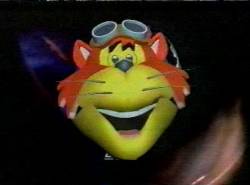 |
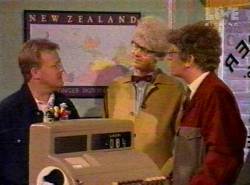 |
The Beeb, meanwhile, saw the end of Schofield’s Saturday reign in ’93, and Bellinger and pals decided a change of crew should mean a change of show – Live and Kicking was born. New set! New theme! New presenters (Forbes promoted from being Scofe’s comic kitchen foil, tottering ego Andi Peters shifted up the ranks from the broom cupboard, a la Phil)! And, well, pretty much exactly the same format as before, really. Videos were still voted on, serious ‘hot seat’ interviews were still conducted about 20 minutes before the end of the show, Risks were still Run, talented viewers were still featured, and Trev and Simon were still there (The Goths, Art For ‘Em, EncycloMedia). The difference was this version was a brand, and for the first BBC time outlived its original presenters (and ‘star of many hit West End shows’ John Barrowman). Moreover, the introduction of Zoe ‘Think Jr.’ Ball and pop cultural memory man Jamie Theakston marked the beginning of the Saturday morning presenter-as-celebrity era (Peters, despite an embarrassingly tearful ‘farewell’ show, was only above the D-list in his own mind). Ratings shot up, tabloids took interest, Trev and Si were pensioned off to make way for more conventional sketch threesome The Cheese Shop, Bro and Bro’s operators created two annoying leprechaun characters, and a Friday afternoon pre-show spin off was briefly aired. Nothing new ever really evolved on L&K in its pomp, no fresh ideas were tried, but for the first time the sheer momentum of publicity (be it word-of-mouth, manufactured or coincidental), coupled with ITV’s complete lack of anything worthwhile in the name of competition, kept the ‘product’ buoyant for much of the decade.
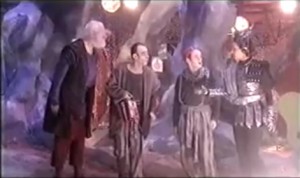 In the summer of ’92 the Beeb’s main show was deputised by the first independently-produced BBC Saturday show, Parallel 9. Made by Roach and Partners at the venerable Pinewood studios, the show went for the ‘quiet, thoughtful’ bucket with an audience-free studio bound format and a sub-Dr Who backstory involving faux-ancient main presenter Mercator, a galactic prince of sorts, banished by a Gallifreyesque committee to a purgatory sat in a crystalline gantry-filled limbo and interviewing Betty Boo. John Craven’s News Swaps were echoed in a segment where Mercator’s young assistant educated him in the week’s events via stones thrown into a pond producing a montage of news footage. On top of all this, it was presented in widescreen (well, they stuck some black bars over the picture). A bold gambit, and one that didn’t fare too well against the muttony fun and games on the other side. Still, two more series were wrung out of the format, with, perhaps predictably, the accent taken off Merc’s sedate planetary education and sub-Roland Rat dinosaur Brian (cortesy original Roland operator David Claridge), Melanie from Neighbours and interactive arcade games introduced along the way. BBC Scotland then took over for Fully Booked with a wafer-thin ‘pop guests staying in a hotel’ conceit, a semi-comic puppet cow, Zoe Ball pre-L&K, Grant Stott and, after a move to Sundays and BBC2 (Saturdays were returned to the linked cartoons ‘n’ drama of old), Wrexham’s very own Tim Vincent and the beginnings of Gail Porter, which proved just palatable enough to remain as a mini summer ‘brand’, with admittedly much tinkering along the way, for several years.
In the summer of ’92 the Beeb’s main show was deputised by the first independently-produced BBC Saturday show, Parallel 9. Made by Roach and Partners at the venerable Pinewood studios, the show went for the ‘quiet, thoughtful’ bucket with an audience-free studio bound format and a sub-Dr Who backstory involving faux-ancient main presenter Mercator, a galactic prince of sorts, banished by a Gallifreyesque committee to a purgatory sat in a crystalline gantry-filled limbo and interviewing Betty Boo. John Craven’s News Swaps were echoed in a segment where Mercator’s young assistant educated him in the week’s events via stones thrown into a pond producing a montage of news footage. On top of all this, it was presented in widescreen (well, they stuck some black bars over the picture). A bold gambit, and one that didn’t fare too well against the muttony fun and games on the other side. Still, two more series were wrung out of the format, with, perhaps predictably, the accent taken off Merc’s sedate planetary education and sub-Roland Rat dinosaur Brian (cortesy original Roland operator David Claridge), Melanie from Neighbours and interactive arcade games introduced along the way. BBC Scotland then took over for Fully Booked with a wafer-thin ‘pop guests staying in a hotel’ conceit, a semi-comic puppet cow, Zoe Ball pre-L&K, Grant Stott and, after a move to Sundays and BBC2 (Saturdays were returned to the linked cartoons ‘n’ drama of old), Wrexham’s very own Tim Vincent and the beginnings of Gail Porter, which proved just palatable enough to remain as a mini summer ‘brand’, with admittedly much tinkering along the way, for several years.
At least the Beeb had the L&K franchise to provide some stability – the late ’90s were chaos on ITV, with series coming and going after one season, none making much of an impact. They tried splitting the morning into two again, with Neil Buchanan’s Media Merchants company fielding the Maidstone studio-based Teleganticmegavision (with a ‘behind the scenes’ fictional conceit similar to Motormouth’s Spin Off) followed by It’s Not Just Saturday!, in which Katie Puckrick, Dannii Minogue and ‘everyone still calls him’ Gaz Top hosted slightly more ‘risque’ teencentric chat. They tried to resurrect the ghosts of Tiswas past in the Sophie Aldred-fronted Wow!, which featured mess, an unusual in-the-round presentation, Norm from the Twix ads, and as much genuine ‘chaos’ as could be achieved, and did it fairly well (various guests even commented ‘it’s just like Tiswas this, isn’t it?’ without too much prompting from Aldred) but not well enough to get recommissioned (it shared its slot with poor Andi Peters pop mag The Noise).
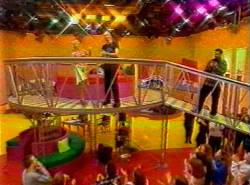 |
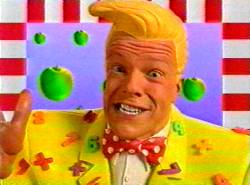 |
They tried getting Mark Speight to impersonate Max Headroom in the over-frenetic Scratchy and Co (alongside undistinguished ‘older kids’ magazine Massive). They tried to have an entire show hosted by a mouthy puppet chimpanzee (Mashed) and a poorly-animated dragon (Tricky). But not very hard. They even tried getting PJ and Duncan to host Gimme 5, but nothing seemed to work. Dark days for the former home of Saturday innovation indeed, and the next concoction to emerge looked just as doomed. A return to two shows per morning, the Byker boys presenting once more, and a hopelessly convoluted “we’re into new media, us” monicker didn’t bode well for SM:TV//Live&CD:UK when it debuted in August ’98. Sure enough, for the first few months of its life it was authentically terrible – stranded-looking presenters, weak gags and poor sound made up a mess of no fun. Along the way to the dumper though, two things happened. Live and Kicking lost its two ‘star presenters’ and started shovelling newcomers into the spotlight at a rate of knots, losing viewers constantly along the way and proving this particular brand was far more dependent on who was fronting it than the Beeb had assumed before being mercifully canned for good. More importantly, Ant and Dec relaxed and found a natural, take-it-or-leave-it style that hadn’t been seen on ITV since No 73 was any good – that is to say, they, er, fooled about and acted natural, a bit like Tiswas and co. 20 years back.
2000 – now: All Change
In which two chancers move on to superstardom, and two more chancers move into a low-rise dwelling.
Perhaps the moment that SM:TV established itself as the top Saturday morning show came in June 1999, where the show ran a Father’s Day phone-in about viewers’ dads. One viewer announced that “For as long as I can remember, my dad has done eggy pumps… he likes to catch them and throw them in my face for a joke, and recently, he’s started pumping in the biscuit tin, and when my friends come round he offers them a biscuit and lets the pump smell out in their faces”. Ant, Dec and Cat spent the next five minutes of the show in a fit of giggles, and from then on, kids knew that the team were on their side. Like all good Saturday shows, it got into trouble on regular occasions – the ITC censured them for product placement when Ant somehow managed to say “Action Man” fifteen times in two minutes, while Dec got knowing laughs for his link into a video from Fat Les – “Here they are, the Fat Lezzers in action!” Soon every celebrity in Britain, often spurred on by their kids, was queueing up to appear in the Chums flat or play Splatoon. Over on the BBC, Ball and Theakston had been replaced by nobodies Emma Ledden and Steve Wilson – but the show was no fun anymore, with no regular comedy slot, dull film reports and a pair of uninspiring hosts. While Ant and Dec were welcoming the likes of Frank Skinner and Lee Evans onto the sofa, the only “grown up” guests Live and Kicking could entice were the likes of Phil Collins.
This meant big changes at the Beeb as, for the first time, radical surgery was needed for their flagship show. After another crappy BBC Scotland filler in the summer ( FBi with Vernon Kay and Boyzon’s Keith Duffy, which could only count on some 400,000 viewers compared to SM:TV’s two million), it was a new look show in the autumn – er, Live and Kicking. There were now four presenters, including former Blue Peter host Katy Hill, Sarah Cawood, and Trey Farley. All the long interviews and serious items were dropped, replaced by more pop and games, but the same production team were still in charge, and with SM:TV on the other side, doing everything Live and Kicking did ten times better, there was absolutely no reason to watch it.
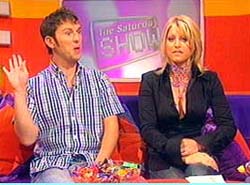 The new Live and Kicking was commissioned to run all year round – presumably to aciod having to come up with another half-arsed replacement in the summer – but from April to September was produced by BBC Scotland. But after just twelve months, time was finally called on the brand, as viewing figures had dipped still further and even the Beeb realised they couldn’t get away with yet another relaunch. So, as we waved goodbye to Katy Hill’s primetime career, September 2001 saw its replacement with the imaginatively-titled Saturday Show . This was billed as an “attitudinal”, “in your face” series, aimed at an older audience, and fronted by Dani Behr and the unlikeable Joe Mace. But of course, the BBC couldn’t really do “sassy”, hence it was just filled with endless games and cartoons, with a house “band” whose role appeared to be singing phone numbers. After a few months, the set was completely changed, more cartoons were added and it became, of course, Live and Kicking again. Fortunately for the Beeb, after three years, problems were afoot at ITV.
The new Live and Kicking was commissioned to run all year round – presumably to aciod having to come up with another half-arsed replacement in the summer – but from April to September was produced by BBC Scotland. But after just twelve months, time was finally called on the brand, as viewing figures had dipped still further and even the Beeb realised they couldn’t get away with yet another relaunch. So, as we waved goodbye to Katy Hill’s primetime career, September 2001 saw its replacement with the imaginatively-titled Saturday Show . This was billed as an “attitudinal”, “in your face” series, aimed at an older audience, and fronted by Dani Behr and the unlikeable Joe Mace. But of course, the BBC couldn’t really do “sassy”, hence it was just filled with endless games and cartoons, with a house “band” whose role appeared to be singing phone numbers. After a few months, the set was completely changed, more cartoons were added and it became, of course, Live and Kicking again. Fortunately for the Beeb, after three years, problems were afoot at ITV.
Ant and Dec had already made some inroads into prime-time television (although their first attempt, the SM:TV spin-off Slap Bang, was a complete flop) and they were getting itchy feet. In December 2001, the duo quit SM:TV. Soon after, Cat decided to leave, and from then on it was chaos, with presenters coming and going from one week to the next. Viewing figures, unsurprisingly, began to draw level with The Saturday Show, which was also undergoing upheaval with the dropping of Behr and Mace and their replacement by the more kid-friendly Fearne Cotton and Simon Grant. Come 2003 and both channels were offering virtually identical Saturday morning shows with similar guests, items, presenters and viewing figures, and neither was particularly interesting. Saturday morning TV seemed to have run right out of steam.
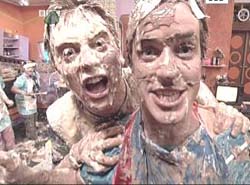 But on the CBBC digital channel, something was afoot. Richard McCourt and Dominic Wood had been CBBC presenters since the mid-90s, and in September 2002, they were asked to link cartoons on weekend mornings on the then-underperfoming channel. With former CITV voice-over artist turned producer Steve Ryde and Otis The Aardvark puppeteer Dave Chapman in tow, what actually appeared was something very different. Dick and Dom in Da Bungalow saw six kids pay a visit to the lads’ “house” to take part in ridiculous gunge-filled games, in between other bits of business like Bogies. Anarchic, free-wheeling and full of jokes for grown-up viewers to enjoy, it soon became a cult favourite for anyone who stumbled upon it (indeed, the shows were soon repeated in the afternoons). The plus point for the BBC was that it was also very cheap to produce. Unsurprisingly, it was then announced that the show would be promoted to BBC1 come September 2003. The same low-budget, imaginative chaos continued, and all of a sudden the Beeb were back in front – with a show that owed a lot to ITV’s finest two hour 25 years before.
But on the CBBC digital channel, something was afoot. Richard McCourt and Dominic Wood had been CBBC presenters since the mid-90s, and in September 2002, they were asked to link cartoons on weekend mornings on the then-underperfoming channel. With former CITV voice-over artist turned producer Steve Ryde and Otis The Aardvark puppeteer Dave Chapman in tow, what actually appeared was something very different. Dick and Dom in Da Bungalow saw six kids pay a visit to the lads’ “house” to take part in ridiculous gunge-filled games, in between other bits of business like Bogies. Anarchic, free-wheeling and full of jokes for grown-up viewers to enjoy, it soon became a cult favourite for anyone who stumbled upon it (indeed, the shows were soon repeated in the afternoons). The plus point for the BBC was that it was also very cheap to produce. Unsurprisingly, it was then announced that the show would be promoted to BBC1 come September 2003. The same low-budget, imaginative chaos continued, and all of a sudden the Beeb were back in front – with a show that owed a lot to ITV’s finest two hour 25 years before.
Meanwhile, ITV decided that SM:TV had run its course, and so after an autumn of compilations linked by the few hosts that were still there, it came to an end in December with Ant, Dec and Cat returning for one final show. Its replacement, come January 2004, was Ministry of Mayhem. ITV said that this show had no interest in attracting an adult audience and was aimed at kids alone. Fair enough, as most of the very worst Saturday shows of the previous decade were those that had attempted to be fashionable. But despite a likeable set of presenters, the Ministry just came across as incredibly dull and old-fashioned – the guest interviews were almost a shot-by-shot recreation of those from Swap Shop. The ‘mayhem’ was half-arsed too – while Dick and Dom were swimming in baths of mushy peas, the Ministry half-heartedly flung the odd custard pie about. The respective climaxes sum the shows up – Da Bungalow saw Creamy Muck Muck, a no-holds-barred fight with buckets of custard. Ministry of Mayhem had… a spelling competition.
But all good things must come to an end, and the Wood-McCourt face-off went for an early bath in 2006, to be replaced, as great programmes so often are, by a Franklin Mint version of itself. Handily symbolising everything that was wrong with the era into which it was falteringly born, TMi roped a pair of failed Pop Idol contestants into a ‘funky flatshare’ format, with plenty of hair gel but anarchy of the strictly monitored scout jamboree variety. This was followed in 2009 by Basil’s Swap Shop, in which the Wrong Kind of Basil Brush merrily despoiled the memory of both his own original show and the original Swap Shop, which shared a name with this new incarnation but little else, the bulk of the ‘fun’ centring around that old standby, the gunge tank. Still, even these crumbs from Mark Thompson’s table were better than what ITV was getting up to, which was nothing at all unless you counted the Wacaday-style early morning budget-dodging shout-em-up Toonattik, which politely buggered off just as the morning was getting up to speed to make way for a load of TV chefs baking flans instead of flinging them. With nothing interesting in the pipeline, children’s TV funding in freefall and station controllers operating on the received wisdom that ‘kids these days are only interested in them Game Boys’, it sadly looks like the tradition of Saturday morning kids’ TV as we know it has finally come to an end, unless someone comes up with something really good, really fast. Don’t suppose Janet Ellis has still got that pinball table in her shed, do you?


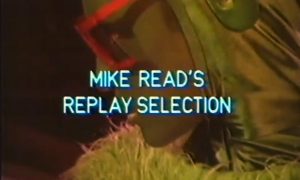



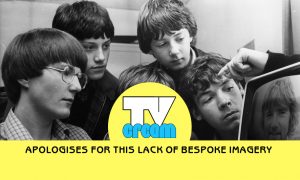



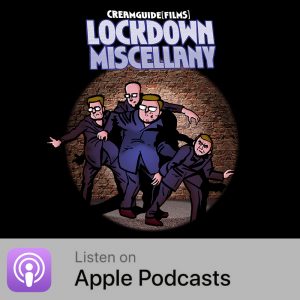
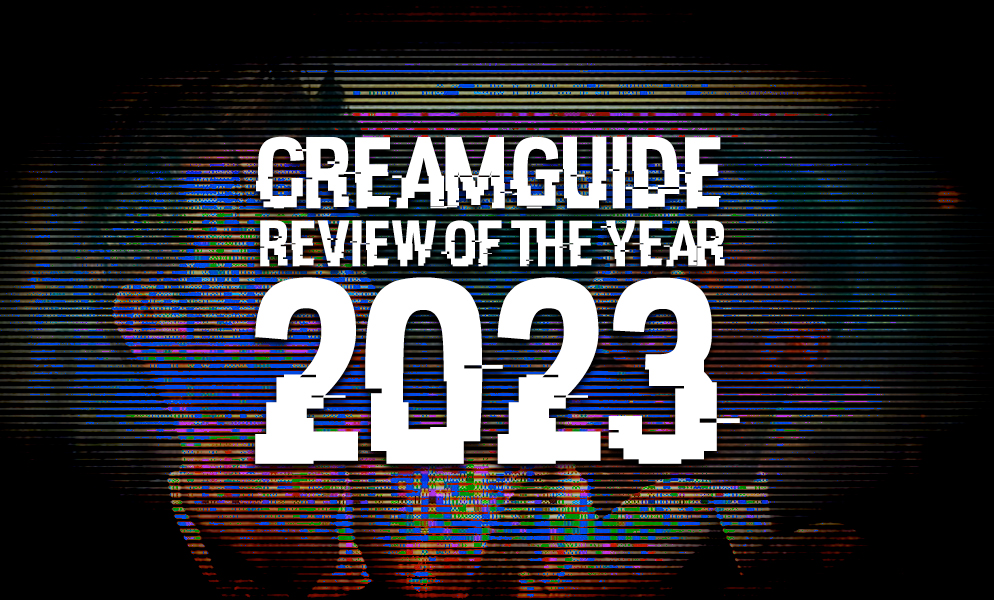
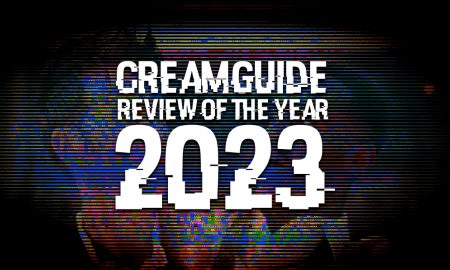
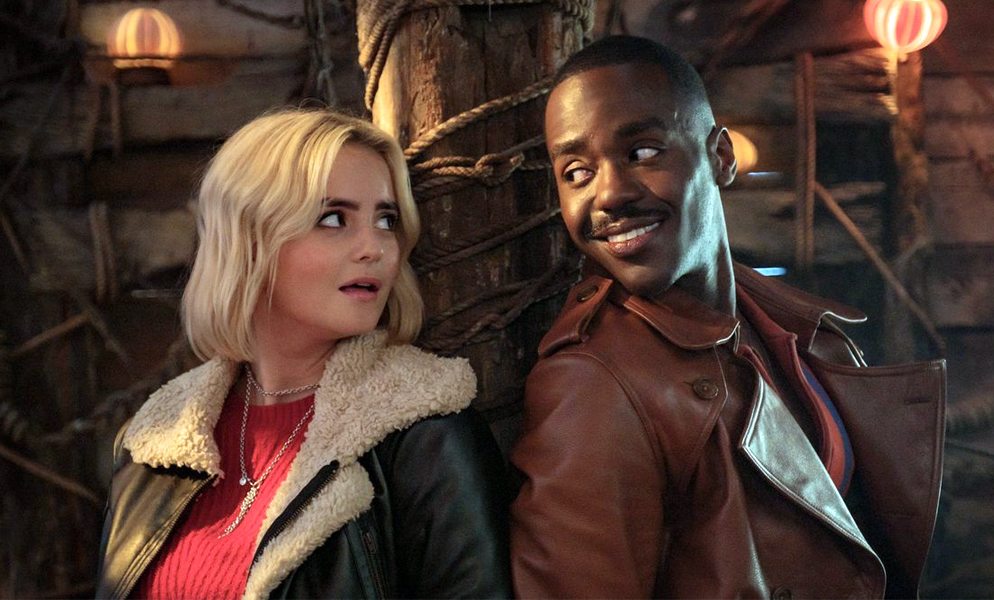
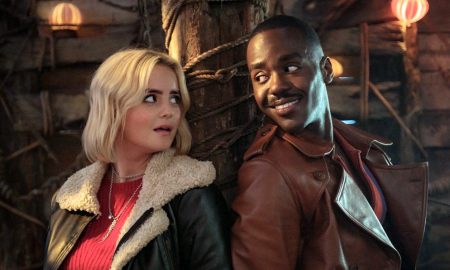
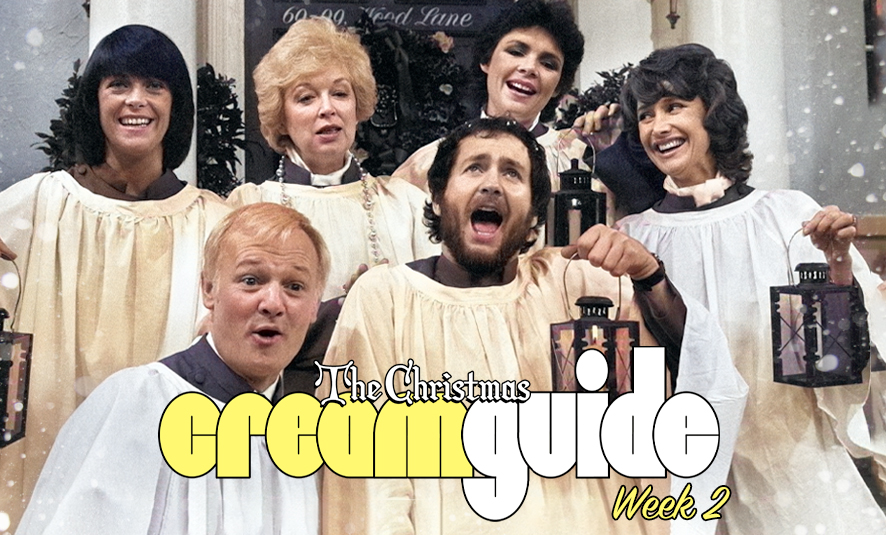
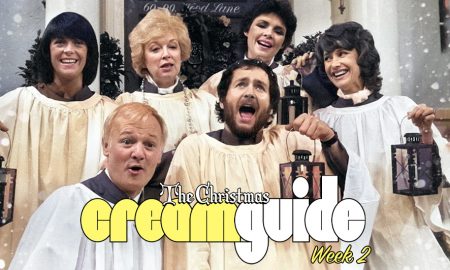
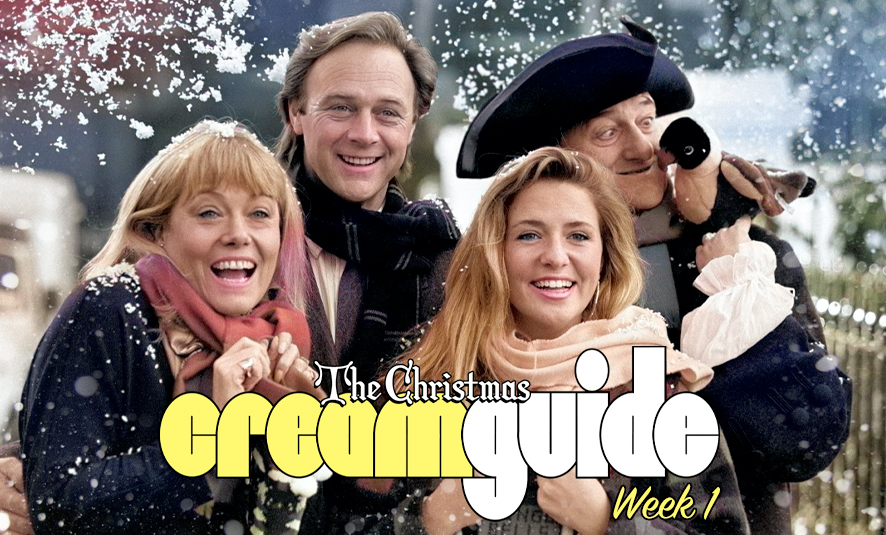
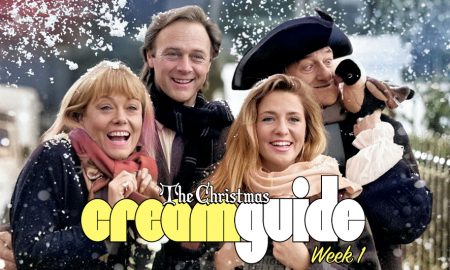
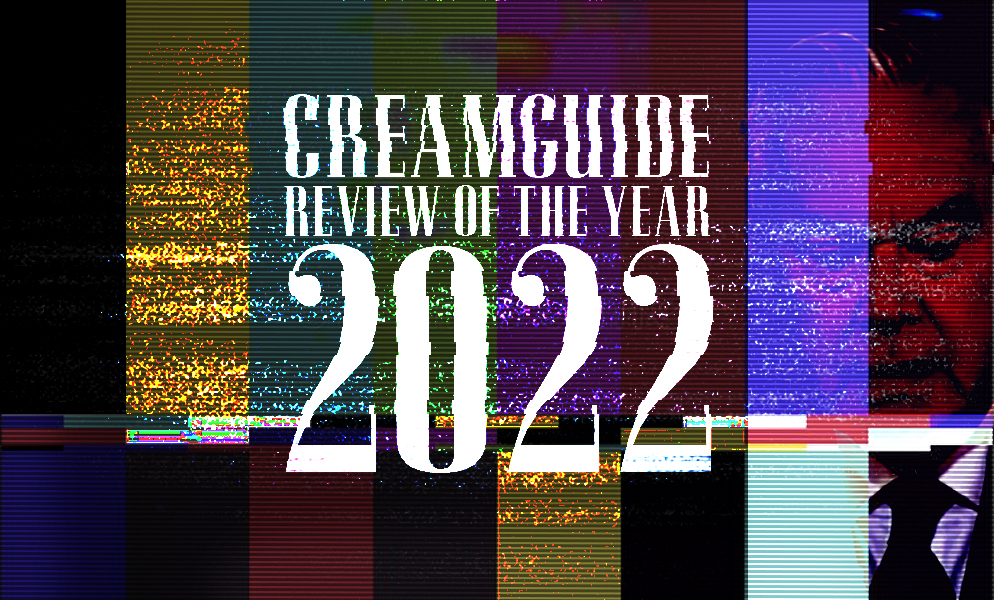
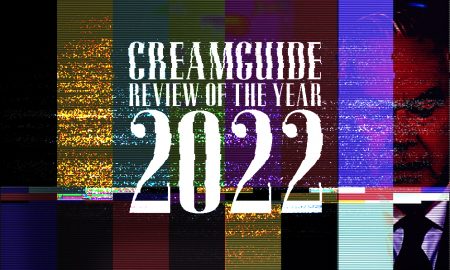

Des Elmes
June 23, 2011 at 10:36 pm
Just to tidy up some loose ends as regards the mid-2000s onwards…
On 13 September 2003, viewers of The Saturday Show were told that it wouldn’t be back until the following April. Perhaps unsurprisingly, a good few of these viewers took that to mean that it wouldn’t be coming back at all – so were no doubt surprised when it did.
For, yes, the Beeb had decided to go back to having an alternative show during the summer.
What wasn’t surprising was yet another new look for TSS, as well as further changes in the presentation team, Jake Humphrey and Angellica Bell joining Simon Grant.
It did well enough to come back for the summer of 2005, during which they broadcast an entire episode from Majorca. But, of course, it still failed to get a lot of people talking…
Then came the news that, from January 2006, the entire BBC1 Saturday morning schedule would move to BBC2, with the likes of Breakfast and Saturday Kitchen heading in the opposite direction. This started out as a three-month trial – which, sadly, The Suits deemed a success and made permanent.
From what I’ve heard, Dick and Dom weren’t too happy about this – even though it had already been confirmed that the current series of Da Bungalow was to be the last…
Also in January 2006, Ministry of Mayhem relaunched as Holly and Stephen’s Saturday Showdown – but, of course, viewing figures didn’t increase and thus it made way for Antony Worrall Thompson and co in June. Seemingly, this pleased Mr McCourt and Mr Wood no end…
Back at the Beeb, summer ’06 brought not one but two shows: The Mighty Truck of Stuff with Reggie Yates, followed by The POD, in which a team of girls took on a team of boys to determine what cartoon, teen drama or whatever would air next.
Then came the first series of TMi – which, interestingly, was broadcast from MTV’s Leicester Square studio.
Then, during 2007/8, the Corporation did some more playing around – ditching summers altogether, making TMi an autumn show only as well as moving it to Television Centre and drastically changing its format, and commissioning a new show for January, February and March. Basil’s Swap Shop was that new show.
Things just about managed to stay that way into the 2010s – before both shows were banished to the CBBC Channel. And that, it appears, was the final nail in the coffin for traditional Saturday morning kids’ TV…
In the year and a bit since, all that has been shown on Saturday morning BBC2 is a standard CBBC and Cbeebies schedule – the closest to a proper magazine-style show being Live ‘n’ Deadly, which features a lot of wildlife but not much else.
BBC1 is still showing Breakfast and cookery shows, of course, while ITV have now resorted to the Corrie omnibus…
Abbie Walton
January 20, 2021 at 3:56 pm
I agree, the BBC should’nt have bothered with TMI, Saturday Mash-Up!, Basil’s Swap Shop at all; in my opinion, Mighty Truck of Stuff should’ve ended a week earlier on BBC1 whilst Holly & Stephen’s Final Showdown would have been broadcast on ITV1 on the same day (1st July 2006) to mark the end of an era of Saturday morning kids’ TV. They could’ve had all the presenters from every Saturday kids show on the final episodes of both, with pre-recorded messages from the presenters who couldn’t make it to gunge.
The cookery shows Saturday Kitchen & Saturday Cooks! should’ve began the following week.
Mark Childs
September 4, 2012 at 11:13 pm
You’ve got a slightly confused narrative here, I think. The ATV series that started in 1974 *was TISWAS … the Today is Saturday, Watch and Smile was a backronym that was invented later. It was this really that established the format for Saturday morning TV, and had done so for a couple of years before Swap Shop got off the ground, so maybe there’s an imbalance in how the influences of the two shows have been represented. I certainly remember thinking Swap Shop was a pale and very staid imitation of the former when it started. And elsewhere on the tvcream site you’ve got Outa Space spelt as Outer Space. I actually remember quite liking this, but … it was 40 years ago so impossible to judge (or remember how to spell it). More on this show and the segments that were in it, if anyone can remember better, would be really interesting.
MewxVenus
April 7, 2013 at 12:47 pm
“mediocre cartoon Centurions”
Are you serious? That’s super nonsense. Would you prefer Get Fresh to broadcast NFL Rush Zone Guardians of the Core instead or whatever show from that era that’s like NFL Rush Zone? Are you from the stone age?
Glenn A
July 6, 2016 at 10:26 pm
I can remember Charlotte Hindle coming to Whitehaven 30 years ago to present the OB section of Going Live, the show being disrupted by heavy rain and she was completely miserable. Suppose you would be after being sent to this remote town she probably never heard of and being soaked.
Glenn A
July 6, 2016 at 10:27 pm
Sorry Get Fresh.
jko100@yahoo.com
August 26, 2016 at 2:53 am
Just a minor comment to point out that LWT were running “Saturday Scene” in the mid to late 70’s, hosted by Sally James. It might not have been LWT produced of course and could easily be from another part of the ITV network, but LWT were running it from at least 1975, possibly earlier. Sally sat behind a desk and linked the morning’s programmes, conducting interviews with pop stars interspersed between the shows. I wish I could remember more about it, but the only two memories I have of it are Slade being interviewed about the movie ‘Flame’ in 1975 and Brotherhood of Man appearing in 1977. How embarrassing that I recall that. It predates ‘Swap Shop’ and certainly predates LWT showing TISWAS, yet is never, ever mentioned. Strange. The morning’s progamming usually ended with ‘Supersonic’ or another pop show that followed it, the name of which escapes me.
Callum J
September 12, 2016 at 8:40 pm
ITV and CITV have Scrambled every Saturday and Sunday morning, which is similar to Toonattik.
Glenn Aylett
January 1, 2017 at 12:52 pm
I can remember Tyne Tees doing an alternative to Tiswas in the winter of 1979-80 which had cartoons and pop interviews and they even did a pop video featuring mildly successful post punk act The Rezillos riding a motorbike through Tynemouth for their minor hit Motorbike Beat. Can’t remember what this show was called and can anyone enlighten me on this?
Andrew Barton
October 13, 2021 at 7:03 pm
There was The Mysti Show as well in 2004, with Yasmin Paige, later of The Sarah Jane Adventures, David Sterne, and Laura Aikman.
The Mysti Show began life as a mix of drama and entertainment with the likes of Phixx, McFly and Kate Garven featuring.
It failed to catch on, so changes were made for Series 2 in 2005. It was reformatted into just a drama with no entertainment stuff (and reduced to being calling Mysti), Jack Liman was replaced as Jack by Christopher Overton as it was decided to make the character older and Ashley Campbell, who played Ollie, was fired, as were Danielle Tabor and Amy Louise Pemberton, who played Snowdrop and Peaceblossom respectively.
The rest of the original cast was retained though (Laura Aikman obviously one of them due to playing the title character) with Peter Blake from Dear John being brought in as a villain wanting to steal Mysti’s powers. Unfortunately it didn’t help the show and it ended shortly afterwards.
Glenn Aylett
October 13, 2021 at 9:19 pm
I often wonder, now the Coronation St omnibus has been shoved to the wasteland of ITV 3 at 0630 on a Saturday morning, if the main ITV channel would every consider a Tiswas style kids show between Good Morning Britain and the cookery at 1200.
Andrew Barton
October 14, 2021 at 8:05 am
The Coronation Street omnibus – didn’t the actors get angry at one point if I recall?
What happened is they had a Saturday afternoon omnibus shown against Grandstand (when that show was still on) and repeats of Cagney and Lacey. It failed to get an audience, so was moved to ITV2. But what happened is it meant some of the actors would get less repeat fees from it.